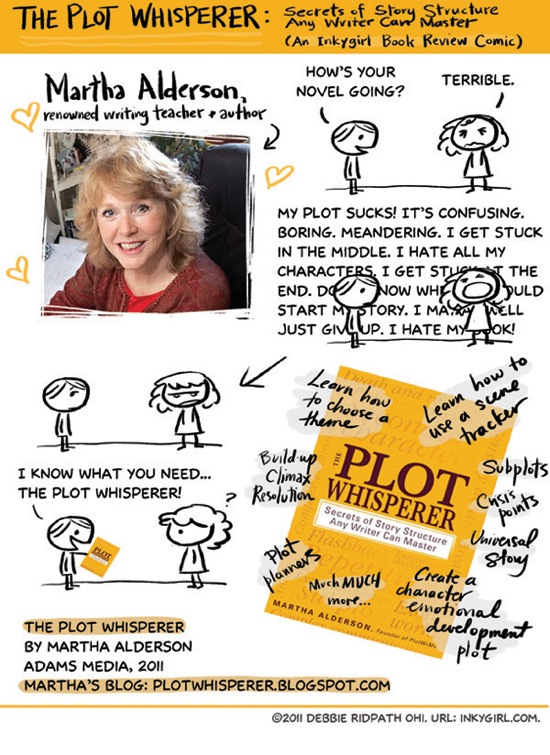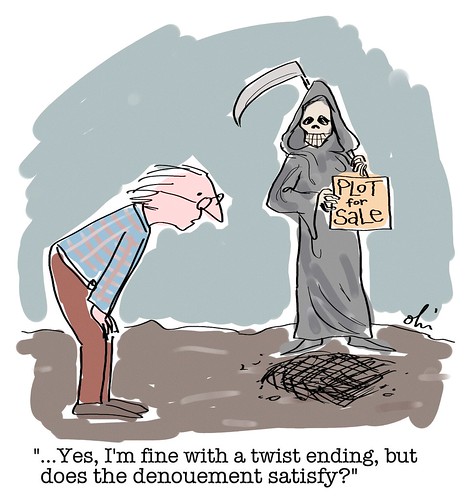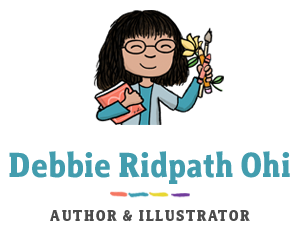
Martha Alderson has worked with hundreds of writers in sold-out plot workshops, retreats, and plot consultations for more than fifteen years. Her clients include bestselling authors, New York editors, and Hollywood movie directors.
Martha’s new book, THE PLOT WHISPERER: Secrets of Story Structure Any Writer Can Master (Adams Media, 2011) is an excellent resource for writers of all levels of experience. Beginning writers will find her templates and clear explanations of basic structure a solid starting point for their work. More experienced writers will find ways to improve their craft even further PLUS (and I hadn’t expected this!) apply some of her basic principles to their own writing/creative lives.
This book isn’t just a list of “do this, don’t do that” writing tips; it encourages you to examine HOW you view yourself as a writer and how you pursue your own career goals.
Martha offers TONS of excellent advice for writers in a variety of interviews and guest posts in her Mega Book Blog Tour.
It’s worth visiting these blogs not just for the great info but also to see how effectively Martha uses this Book Blog Tour to promote her nonfiction book by interacting with blog readers as well as offering real and useful content. So many times I see blog tours in which the author just gives teasers but spends most of the time saying WHY people need to buy her book. Martha’s generous with sharing her knowledge, and I believe this is a far better way to show readers what her book can offer them.
Anyway, here’s a round-up of tidbits I found at the blogs in her tour…
Janet Fox at Through the Wardrobe:
You may find the first draft is wobbly and scenes ramble. The complete vision of your story was a bit hazy the first time through. The action was tangled. The protagonist comes off as bewildering. You have glossed over an energetic marker or two. Don’t panic—this is good. As a matter of fact, the worse the first draft, the better. Trying for perfection before you know what you are trying to convey commonly leads to procrastination.
Teresa LeYung Ryan at Love Made of Heart:
On figuring out which subplots in a story have merit and which should be dumped…
Three comments:
1) follow the energy — at least with the first draft. When a writer is energetically engaged in developing one plot line over another, they’re more apt to write all the way to the end, which then makes it much easier to assess what the story is all about.
2) character and action are the yin and yang of stories. Every story benefits from the development of both!
3) create a master plot planner and line up the multiple plots one above the other — usually the primary plot shines through…

Becky Levine at Moving Forward on the Writing Path:
Martha believes in plot. She recognizes that there are many writers who worry that, by plotting, they’ll make their story stiff or formulaic. She recognizes and respects that fear, but she also reassures us–rightly, I think–that the plot is the container, the structure, that holds all the magic we could ever want to write. And she coaches us through all the steps of creating that plot.
Mary Baader Kaley at Not an Editor:
On how Martha critiques someone’s work (her general process):
I never critique writers’ work. I have found as a plot consultant to writers that I cannot see the forest (plot and structure) for the trees (words). Plot consultations focus exclusively on the master plot, which is made up of the action, character and thematic plot lines or, in other words, the form and structure. Writers are asked to have on hand a list of scenes from their projects and an idea of the message they are hoping their story will convey.
By pushing aside the words, I am better able to see the deeper structure of the story and assess what is working and what needs work.
Kelly Klepfer of Novel Rocket:
On why Martha advises writers NOT to show their first drafts to anyone:
Allow others to read your writing now and you may lose energy for your story and become overwhelmed by the task ahead of you.
On the Universal Story:
The part of the book I am most excited about is the story beneath the story – the Universal Story and the message that writing is transformative. I hope writers come away from this book with practical techniques to integrate the energy of the Universal Story into their stories. After using these ideas, I believe writers will begin to understand themselves better. They’ll see their writing in a different light. The ways they interact with their writing and with the world around them will shift.
Shreve Stockton at Honey Rock Dawn:
Now, with The Plot Whisperer, Martha takes this essential information even further. Further and deeper. Martha has been doing one-on-one writer’s consultations for years and this is what reading The Plot Whisperer feels like ~ it’s like sitting with her and being coached, psychoanalyzed, pushed, encouraged, and, via all of that, INSPIRED to get down and write.

Martha offers time management tips for those participating in NaNoWriMo:
While keeping that word count in mind, at the same time, writers who understand how to use the time most effectively based on the Universal Story, find themselves at the end of November with more than just 50,000 words (though that is an admirable accomplishment in itself).
Writers who are savvy about the parameters of the Universal Story finish out the month with a definable beginning, middle and end.
Sherrie Petersen at Write About Now:
On why it doesn’t really make a difference if you use an outline or not for your first draft:
I don’t care how you write the first draft. Just get it written all the way from the beginning to the end anyway you can – pre-plotting, plotting as you write, or writing purely by the seat of your pants. With a completed draft, no matter how wretched you may believe it is, you can then get down to the real work of plot and structure.
Charissa Weaks at A Day in the Life of An Author:
On how to determine which parts of the backstory to include in your story:
I recommend writing the first draft all the way from the beginning to the end one time with absolutely no back story other than how that back story influences the protagonist’s reactions in scene in real story time.
Two common mistakes I see writers make is giving up before writing to the end of the story and rushing through writing the end of the story as if with eyes squeezed shut on a wing and a prayer that all of the words will add up to something meaningful and make sense in the end.
Uma Krishnaswami (Writing With A Broken Tusk):
I suggest using what I call a Scene Tracker. It’s a template or worksheet that allows you to plot out the seven essential elements in every scene you write. To analyze scenes at a thematic level before you have written a draft or two is usually premature. Far better is to wait until you better understand the deeper meaning of your piece. Then, stand back and analyze each scene for thematic elements which allows you to see where they show up now and where they could be inserted to create the most pleasing patterns for the reader and for the greatest good of the story.
Linda Joy Myers (President, National Association of Memoir Writers) at Memories and Memoirs:
For each scene, ask yourself the seven essential questions of plot:
1. Does the scene establish the date and setting?
2. How does it develop the character’s emotional makeup?
3. Is the scene driven by a specific character goal?
4. What dramatic action is shown?
5. How much conflict, tension, suspense, or curiosity is shown?
6. Does the character show emotional changes and reactions within the scene?
7. Does the scene reveal thematic significance to the overall story?
For More About Martha:
Her blog: http://plotwhisperer.blogspot.com/
She’s on Twitter (@plotwhisperer ) and on Facebook.
On YouTube: Martha’s Plot Series — This is how I discovered Martha — excellent videos! Here’s the first in her video series…
—–
p.s. I’ve had a growing number of people approach me about reviewing their books or inviting me to be part of their blog tours. Please note that in most cases I have to decline. Apologies, but I simply lack the time. In Martha’s case, I had already been a big fan of her video series, plus I wanted a free copy of her book.
For more insights from book creators, see my Inkygirl Interview Archives and Advice For Young Writers And Illustrators From Book Creators.
Also see Debbie’s Reading Journal as well as Debbie’s Bookstagram.


